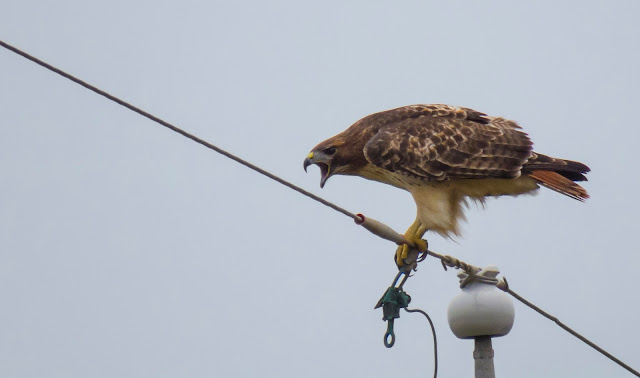On this winter trip to Mustang Island SP, one of our hopes was to catch sight of the Whooping Cranes in and around Aransas National Wildlife Refuge (ANWR). Earlier this fall, we had seen a large flock of Sandhill Cranes flying over the Canyon of Eagles campground but had no luck finding them on the ground. In this post, I summarize our crane adventures on this trip.
November 25 - Near the Big Tree - Our first and best sighting actually happened by accident. The weather at the beginning of the week was far too cold to kayak, so we had driven up to Goose Island State Park to see what bird life we could find by the fishing pier. We did see an Oyster Catcher and a few Willets but, otherwise, not much.
After getting "kicked off" of the pier for having our Labrador with us, I was fuming and hinting at going back to the coast, but Danielle suggested we go see the Big Tree, which we missed on our last trip. While viewing the impressive tree, Danielle pointed out two cranes flying overhead through the tree cover; I couldn't get an identification for them in that brief glimpse.
We then went exploring around the neighborhood and spotted a small group of what looked like cranes milling around on one of the properties in the distance. Binoculars convinced us there was a good chance we had found Whooping Cranes! We walked the quarter mile to the spot on 8th Street shown below and found the cranes gathered about 400 ft away from us.
The properties were all marked with "No Trespassing" signs, and we stuck to the road with a few other bird-watchers. We were glad to have our little super-zoom camera. We both observed with binoculars and took pictures for about an hour. Below is a shot of all of the birds in one frame.
 |
| Canon SX50 HS - ISO-400, f/5.6, 1/125s |
There are a total of seven Whooping Cranes and three Sandhill Cranes. The bird on the far left had a pair of leg bands; none of the others did. Here is a close-up of the leg bands as seen from behind
The tan and white mottled crane second to the right is a juvenile Whooping Crane. We were impressed by how large the Whooping Cranes are! This is especially evident in comparison to the Sandhills. This location must be a common hang out for the cranes since we saw several bird blinds set up (see one at the tree line below) and met a number of other folks driving by to check on them.
Here is a close-in crop of one of the cranes.
 |
| Canon SX50 HS - ISO-500, f/6.5, 1/160s |
We especially liked this next image, which shows the juvenile accompanied by two adults. I don't know if these are the parents or not.
 |
| Canon SX50 HS - ISO-500, f/6.5, 1/160s |
We tried to get some shots of the cranes flying or spreading their wings, but the little camera was not up to the task on this overcast day.
November 26 - Aransas NWR Observation Tower - The next day, we set out to find more cranes at ANWR, where we had originally expected to find them. Our first stop there was the observation tower at the southern end of the park. This observing platform overlooks a wide expanse of salt marsh as shown in the map below.
Close up, the only birds we saw were Turkey Vultures roosting in the trees below us. At home, we always see these above us. The change in perspective merited a picture!
On the distant marsh we saw a Roseate Spoonbill and a few Great Blue Herons. We also saw two Whooping Cranes. Though far away, this observation was fun because we got to watch them feed in the water, dunking their head under like egrets. This shot below was taken from 1700 ft as measured on the map! Wow, without binoculars, I could barely see the birds. We did not observe bands on either of these cranes.
 |
| Canon SX50 HS - ISO-1250, f/8, 1/320s |
November 26 - Aransas NWR Heron Flats - Our second encounter was along the Heron Flats trail, the lower portion of which was open. Access from the upper parking lot was not possible. This was a great trail and yielded views of egrets, herons, ibis, and ducks. This time, the flock of cranes was about 800 ft out and consisted of a pair of Whooping Cranes amid a couple dozen Sandhills. We heard the Sandhills long before we saw them; their natural camouflage is pretty effective.
Here is a shot of some of the Sandhill Cranes on the marsh as the sun was setting.
 |
| Canon SX50 HS - ISO-1600, f/7.1, 1/200s |
In this shot, we tried to capture some of the Sandhill Cranes displaying to each other in some sort of "kick boxing" posture. Interesting that the two species don't really engage each other. Again, we did not observe bands on either of these Whooping Cranes.
 |
| Canon SX50 HS - ISO-250, f/6.5, 1/160s |
Though very grainy at high ISO, a view of a crane with wings extended
 |
| Canon SX50 HS - ISO-1600, f/6.5, 1/320 |

























